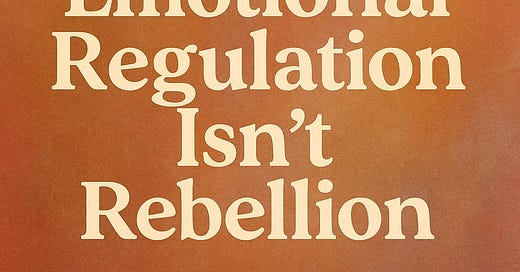Return to the Emotional Heresy Series Hub
How We Heal Without Becoming Numb
A word to the reader:
If you grew up in a world where emotion was treated like a fire—dangerous, unpredictable, something to extinguish—then learning to feel without fear is its own kind of miracle.
If you’ve ever confused regulation with repression, or healing with hardening, or peace with passivity—this is for you.
Because emotional regulation is not rebellion against your true self.
It’s the long walk home to it.
I. We Were Taught to Be Either Explosive or Empty
In many systems—religious, cultural, familial—there was no middle ground.
You could be stoic and praised.
Or emotional and punished.
You could either suppress your feelings and be seen as strong…
Or express them and be labeled unstable, dramatic, disobedient, irrational, or sinful.
There was no language for emotional presence.
Only the extremes: silence or chaos.
Shutdown or outburst.
Frozen or flooded.
So we chose what felt safest.
We went numb.
Or we learned to perform.
Or we cracked open, over and over, because no one had taught us another way.
Emotional regulation was never modeled as liberation.
It was taught as compliance.
II. Regulation Is Not Suppression. It’s Compassion in Motion.
Let’s say this plainly:
Regulating your emotions doesn’t mean shrinking them.
It means creating space for them to be felt fully, held safely, and expressed wisely.
It is the practice of:
Recognizing what you feel without running from it
Sitting with your anger without needing to destroy
Allowing your grief without drowning in it
Moving through fear without letting it drive
This isn’t weakness.
It’s the deepest kind of strength.
It’s the ability to say:
“I don’t have to prove my pain by spilling it.
I don’t have to protect myself by suppressing it.
I can hold it, honor it, and still choose how I move.”
III. Why This Terrifies the Systems That Trained Us
Systems that rely on emotional suppression do not fear outbursts.
They expect them.
They use them to discredit you.
What they fear is this:
A person who can feel deeply—and stay grounded.
A person who can speak truthfully—without losing themselves.
A person who knows how to cry without shame, to pause without panic, to say “no” without apology.
Because that kind of presence…
Can’t be manipulated.
Can’t be gaslit.
Can’t be silenced.
That kind of person is dangerously free.
IV. Healing Doesn’t Mean Becoming Unbothered. It Means Becoming Honest.
There’s a myth—especially in wellness culture—that emotional regulation means becoming untouched by pain.
That healing equals “peaceful at all costs.”
That you should be able to sit in the face of injustice, cruelty, or betrayal and smile calmly, like a monk on a mountain.
But that’s not healing.
That’s spiritual disassociation.
Real healing says:
“This hurts. And I’m allowed to name it.”
“I can feel rage and still stay rooted.”
“I can choose not to explode—but I also won’t shrink.”
“My peace doesn’t come from avoiding discomfort. It comes from knowing I can move through it without abandoning myself.”
Regulation isn’t about shrinking your heart.
It’s about widening your capacity to hold what it carries.
V. When We Heal, We Stop Making Our Feelings Someone Else’s Responsibility
This is the secret of healing that often gets lost:
When we were silenced, we often wanted our pain to be heard so badly, it came out as a demand.
When we were dismissed, we learned to escalate to be taken seriously.
But once you learn to regulate—not by shutting down, but by truly staying with yourself—you no longer need someone else to fix, validate, or rescue your emotional state.
That doesn’t mean you don’t need people.
It means your need for them is no longer rooted in self-abandonment.
And this shift?
It’s where boundary meets empathy.
It’s where freedom begins.
VI. Emotional Regulation as Sacred Witness
You can weep like Jesus.
Flip tables like Jesus.
Withdraw like Jesus.
Speak hard truth like Jesus.
And still be regulated.
He never stopped feeling.
But he never gave his power away to those feelings either.
He knew when to cry, when to walk away, and when to speak with fire.
That is what regulation looks like—not robotic calm, but embodied discernment.
You don’t have to go numb to grow.
You don’t have to become hardened to be holy.
You don’t have to become smaller to be taken seriously.
You can feel.
You can stay.
You can speak.
And still be safe inside yourself.
VII. A Question for Reflection
When was the first time you were praised for not feeling?
What part of you got left behind when you decided being calm was safer than being real?And what might change if regulation meant holding your emotion with reverence, not taming it out of fear?




